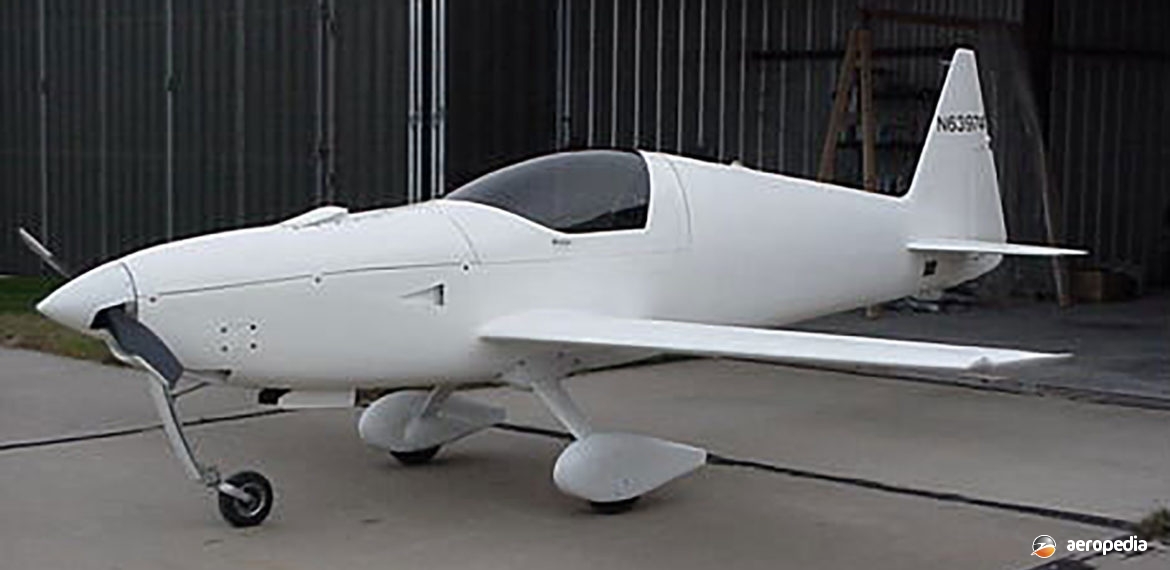Photograph:
A Lightning Bug completed in the United States (Author’s collection)
Country of origin:
United States of America
Description:
Single-seat high-performance aerobatic monoplane
Power Plant:
One 75 kw (100 hp) AMT 808 three-cylinder in-line air-cooled engine
Specifications:
- Wingspan: 5.43 m (17 ft 8 in)
- Length: 5.32 m (17 ft 4 in)
- Wing area: 3.71 m² (40 sq ft)
- Max speed: 402 km/h (250 mph)
- Max cruising speed: 362 km/h (22 mph)
- Stalling speed [clean]: 137 km/h (85 mph)
- Stalling speed [landing configuration]: 100 km/h (62 mph)
- Rate of climb: 366 m/min (1,200 ft/min)
- Service ceiling: 6,096 m (20,000 ft)
- Range: 1,416 km (880 miles)
- Fuel capacity: 87 litres (19 imp gals)
- Empty weight: 215 kg (475 lb)
- Loaded weight [aerobatic configuration]: 340 kg (750 lb)
- Normal loaded weight: 431 kg (950 lb)
History:
Designed by Nick Jones, the Lightning Bug was a follow-up to the high-performance four-seat aircraft by the same designer, the White Lightning, but was entirely different in being a single-seat high-performance monoplane for aerobatic work. Mr Jones eventually ceased production of the series. Unfinished kits and material were obtained by Will Matthews of Las Cruces in New Mexico and placed in storage in his hangar. He had for some years operated a White Lightning in racing configuration at the Reno Air Races in Nevada, USA.
Eventually the series rights were obtained by Reflex Fiberglass Works of Walterboro, South Carolina, USA and kits and plans became available again. The Bug was constructed of fibreglass, epoxy moulded parts and stainless steel. The kit was complete and included engine, propeller and instruments. The undercarriage was constructed of pre-bent 7075-T6 with 2-500-5 disc braked wheels. It had a retractable undercarriage.
The Bug was designed to meet FAR Part 23 aerobatic regulations. Power plant used on the type was the AMT 808 three-cylinder in-line two-stroke dual ignition L-95 and L-100 variants, each weighing 59 kg (130 lb). A feature of these engines included loss capacitor discharge ignition, liquid cooling, fuel pump, cast iron cylinder liner, ball, needle and roller bearings. It was offered with an optional gearbox reduction system and starting was by an electric starter. The engines were the L-95 which, through three carburettors, produced 71 kw (95 hp) and the L-100 which also had three carburettors and produced 75 kw (100 hp) at 7,000 rpm.
It is believed about 16 kits were sold when first released. Mr David Limmer of Beulah Park, SA obtained two kits and shipped them to Adelaide, SA in February 2009. He decided to build one powered by two jet engines, to be known as the Komet and, with the assistance of two other builders, modified the design to suit this form of powerplant. Major changes included a change to a nosewheel configuration, converting to two-seat form, an all-metal tailplane from a Vans RV-8 in lieu of the fibreglass unit, and a 38 cm (15 in) stretch of the fuselage to offset the heavier tailplane.
The two jet engines, which are mounted on pylons aft of the rear cockpit, are of 150 lbst. Dual controls are fitted. Endurance was expected to be half an hour. A ferry tank was designed and could be fitted, this being installed when required in the rear cockpit, permitting the pilot to fly at 5,486 m (18,000 ft) with oxygen and giving a VFR range of 463 km (288 miles). Max level speed was estimated at 445 km/h (276 mph). Empty weight was 200 kg (440 lb), loaded weight was 431 kg (950 lb), and fuel capacity was 100 litres (22 Imp gals).
The first Lightning Bug completed in Australia became VH-EMK4 (c/n 6) to its owner / builder Milton King of Parkside, SA on 15 November 2017, this aircraft being fitted with a 3300 six-cylinder fuel injected piston engine.

